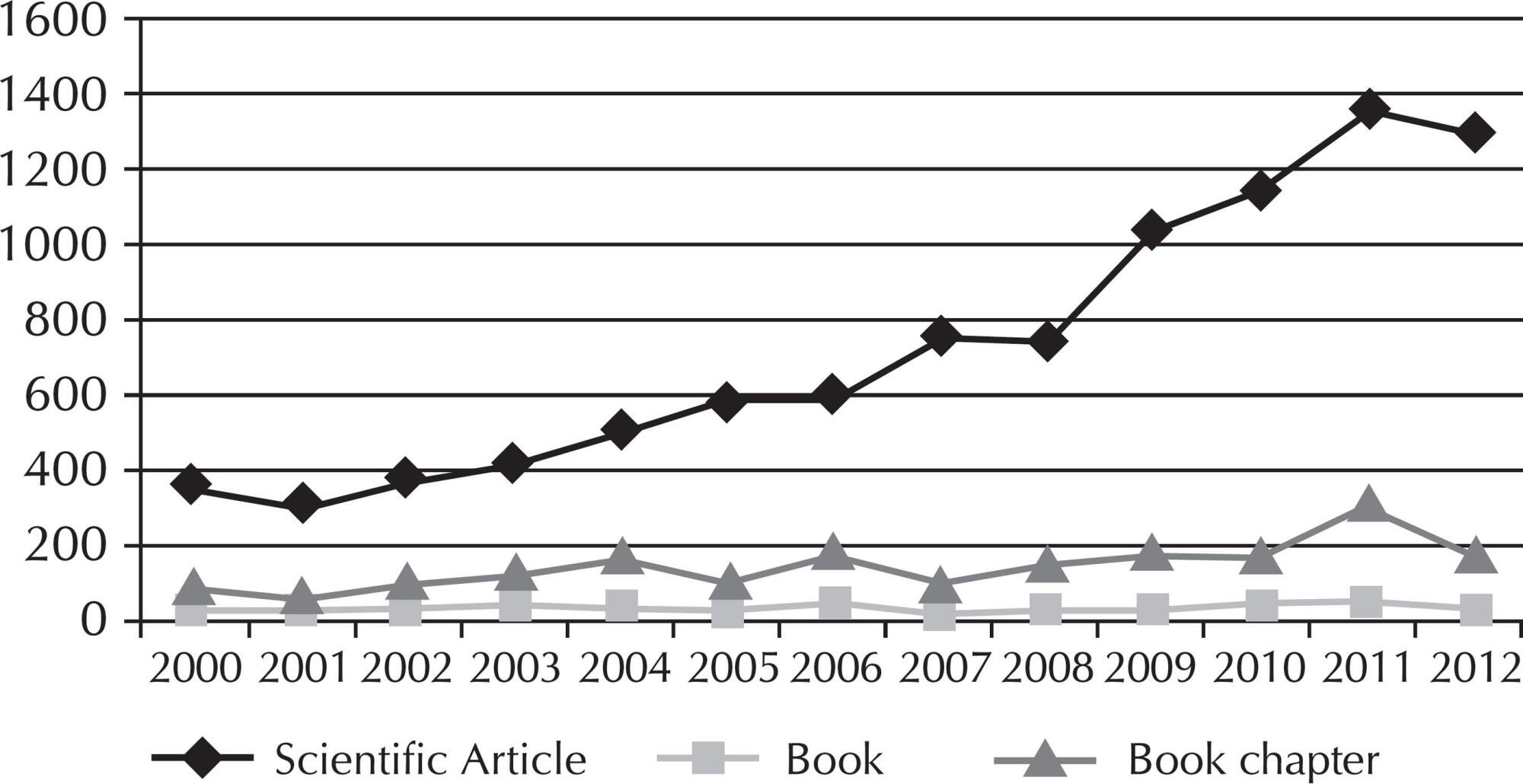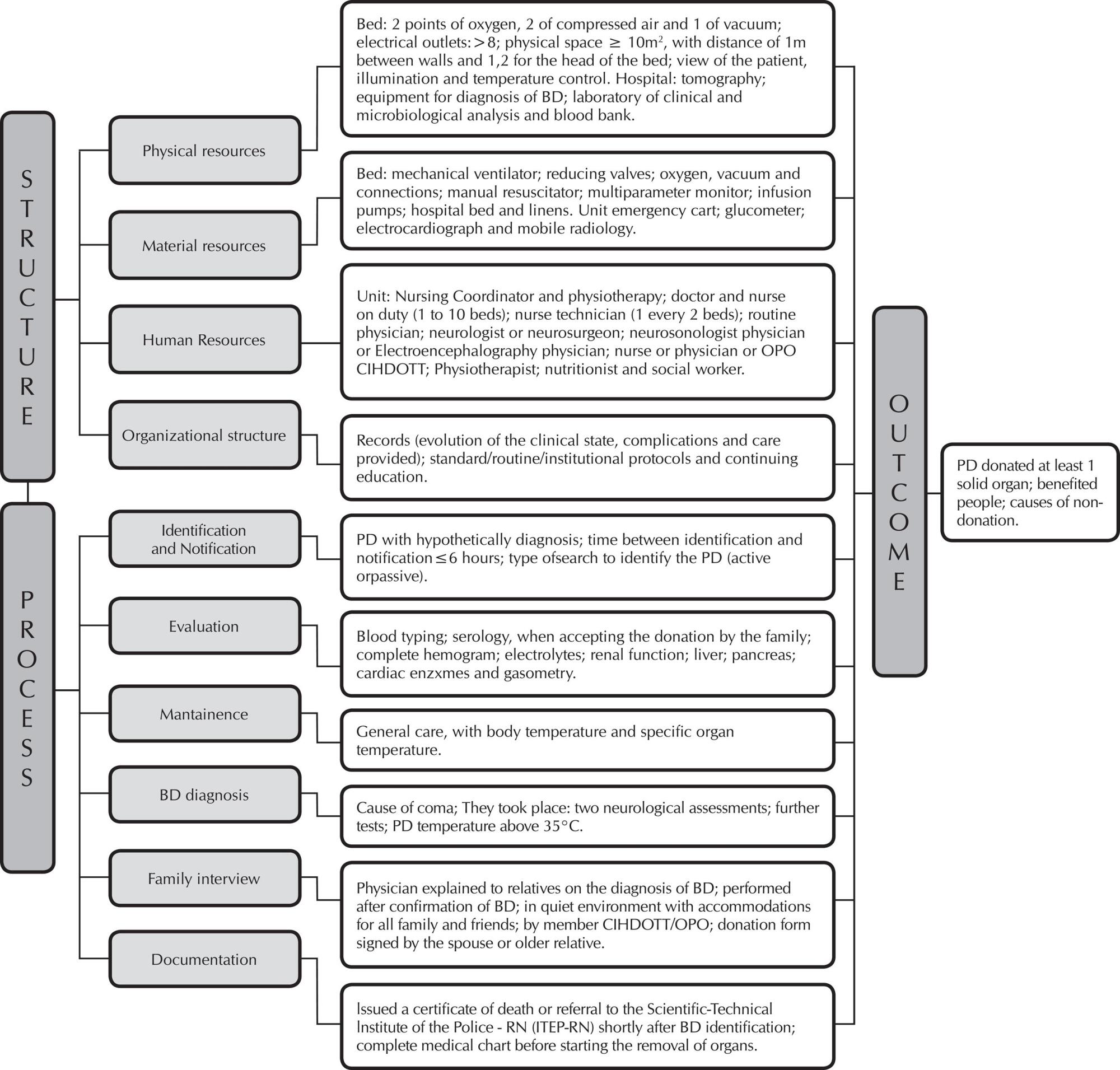-
01-01-2015
Ineffective airway clearance: accuracy of clinical indicators in asthmatic children
Revista Brasileira de Enfermagem. 2015;68(5):862-868
Abstract
Ineffective airway clearance: accuracy of clinical indicators in asthmatic children
Revista Brasileira de Enfermagem. 2015;68(5):862-868
DOI 10.1590/0034-7167.2015680514i
Views0See moreABSTRACT
Objective:
to analyze the accuracy measurements of clinical indicators of the nursing diagnosis Ineffective airway clearance.
Method:
cross-sectional study with 205 asthmatic children treated in the emergency unit of a hospital in the city of Fortaleza, Ceará. An interview script and pulmonary evaluation were used for data collection.
Results:
the diagnosis of Ineffective airway clearance was present in 89.3% of the sample. The most prevalent clinical indicators were dyspnea, change in respiratory rate, change in respiratory rhythm, orthopnea, adventitious respiratory sounds and ineffective cough. The clinical indicators with highest sensitivity were dyspnea, change in respiratory rate, change in respiratory rhythm, orthopnea and adventitious respiratory sounds. Ineffective cough and adventitious respiratory sounds were the indicators with best specifi city.
Conclusion:
the clinical indicator adventitious respiratory sounds was the best predictor of Ineffective airway clearance in asthmatic children treated in emergency units.
-
01-01-2015
Mortality from external causes in Pernambuco, 2001-2003 and 2011-2013
Revista Brasileira de Enfermagem. 2015;68(5):855-861
Abstract
Mortality from external causes in Pernambuco, 2001-2003 and 2011-2013
Revista Brasileira de Enfermagem. 2015;68(5):855-861
DOI 10.1590/0034-7167.2015680513i
Views0See moreABSTRACT
Objective:
to describe the mortality from external causes, by Health Regions in Pernambuco, during the periods of2001-2003 and 2011-2013.
Method:
descriptive study with data from the Mortality Information System. For data analysis we used percentage, percentage variation and proportion ratio.
Results:
mortality from external causes reduced in Pernambuco, however, mortality increased in some health regions of the countryside. Increased numbers of deaths from accidents and event of undetermined intent were registered. There was an increase of deaths classified as “other/unspecified” event of undetermined intent.
Conclusion:
there was a change in the spatial distribution of mortality from external causes moving to Pernambuco countryside regions. We found necessity for data classification regarding deaths from external causes and strengthening of the monitoring.
-
01-01-2015
Evaluation of scientific production, patents and human resources training in the Brazilian nursing
Revista Brasileira de Enfermagem. 2015;68(5):846-854
Abstract
Evaluation of scientific production, patents and human resources training in the Brazilian nursing
Revista Brasileira de Enfermagem. 2015;68(5):846-854
DOI 10.1590/0034-7167.2015680512i
Views0See moreABSTRACT
Objective:
to evaluate scientifi c production, patents and human resources training of nursing researchers with scholarships of research productivity (PQ) in National Counsel for Technological and Scientific Development (CNPq) in the 2000-2012 historic series; to verify the association between this production and characteristics of the researchers regarding gender, education and origin.
Methods:
this analytic cross-sectional study whose inclusion criterion was to be a nursing PQ/CNPq researcher during the period in question. We analyzed curriculum lattes of 208 researchers with scholarships between 2000 and 2012. For statistical analyses we used the SPSS® software.
Results:
the study points to female predominance, concentration in the Southeast region and existence of an association between scientific production, patents and human resources training and education, gender and origin of the researcher.
Conclusion:
the study presents a significant participation of nursing PQ/CNPq researchers in scientific production and in human resources training, and a modest involvement in the production of patents.

-
01-01-2015
Structure, process and outcomes of organ and tissue donation for transplantation
Revista Brasileira de Enfermagem. 2015;68(5):837-845
Abstract
Structure, process and outcomes of organ and tissue donation for transplantation
Revista Brasileira de Enfermagem. 2015;68(5):837-845
DOI 10.1590/0034-7167.2015680511i
Views0See moreABSTRACT
Objective:
to analyze the factors related to the structure, process and outcomes of organ and tissue donation for transplantation.
Method:
analytic, longitudinal and quantitative study, conducted in six hospitals in Natal/RN, between August 2010 and February 2011, with 65 potential donors (PD), by means of no participant observation structured script.
Results:
regarding the donation structure, there was deficiencies of physical resources (temperature control), materials (mobile radiology) human resources (nurse technicians) and lack of adequate records and care protocols. In the process of donation, the biggest problems were related to the evaluation stages, brain death diagnosis, maintenance and documentation, with greater proportion of care for the non-donor.
Conclusion:
the structure and process possibly determined the result of 72.3% no donation implementation of potential donors, indices compatible with the national data, but contradictory to those of Spain, which manages to transplant organs of 86.7% of its donors.

-
01-01-2015
The nurse in the area of collective health: conceptions and competencies
Revista Brasileira de Enfermagem. 2015;68(5):830-836
Abstract
The nurse in the area of collective health: conceptions and competencies
Revista Brasileira de Enfermagem. 2015;68(5):830-836
DOI 10.1590/0034-7167.2015680510i
Views0See moreABSTRACT
Objective:
to learn coordinators and professors’ conceptions from undergraduate Nursing courses of public universities in northern Brazil regarding collective health and to know the necessary competencies to work in the area.
Method:
data were collected through semi-structured interviews and subjected to thematic analysis.
Results:
the participants consider population health as an essential area for the training of nurses, where professionals have autonomy and confidence. It is an interdisciplinary, intersectoral and multidisciplinary field, with extensive scope, that studies the Unified Health System (SUS). The competencies to work in collective health identified were: to work at the SUS, to understand the health and disease process and its determinants and to develop actions towards integrality, to conduct health education, researches and systematization of the nursing care.
Conclusion:
the variety of conceptions about collective health among participants might reflect in training of nurses and their working area.
-
01-01-2015
Level of dependence among patients in a surgical unit
Revista Brasileira de Enfermagem. 2015;68(5):824-829
Abstract
Level of dependence among patients in a surgical unit
Revista Brasileira de Enfermagem. 2015;68(5):824-829
DOI 10.1590/0034-7167.2015680509i
Views0See moreABSTRACT
Objective:
to identify the complexity of the nursing care of inpatient surgical unit patients, using the Perroca patients classification scale.
Method:
a descriptive, cross-sectional study with 546 reviews of 187 patients between October and December of 2012. Data were analyzed using SPSS 18.0 and the Kappa test, to measure interrater agreement.
Results:
a predominance of patients in the categories of semi-intensive (46.5%) and intermediate care (44.0%) was found, with a prevalence of unassisted bath (58.4%) in the total sample, and bed bath (69.3%) in the semi-intensive care patients. The level of agreement between two pairs of raters was considered good.
Conclusion:
the systematic application of the instrument was useful as a complementary measure of the level of patient dependence, and may contribute to the improvement of the working process, refl ecting on management decision-making with regard to nursing workload
-
01-01-2015
Psychological violence in the nursing work
Revista Brasileira de Enfermagem. 2015;68(5):817-823
Abstract
Psychological violence in the nursing work
Revista Brasileira de Enfermagem. 2015;68(5):817-823
DOI 10.1590/0034-7167.2015680508i
Views0See moreABSTRACT
Objective:
to investigate and characterize psychological violence practices within teams in the relationship between patients, caregivers and other professionals with the nursing staff of the public hospital network of Caxias, in the State of Maranhão, Brazil.
Method:
descriptive, quantitative, cross-sectional study with data collected by form between November/2013-May/2014.
Results:
verbal aggression is the most common psychological violence subtype 95% (84), followed by bullying 27% (24). Emergency rooms 51% (45) are the most frequent place; patients 60% (53) are the main aggressors; nurses 76% (19) suffer more violence, being mostly female, young and inexperienced.
Conclusion:
the largest number of occurrences was of verbal aggression perpetrated by patients against nurses in the emergency room. Workers try to pretend that nothing happened or are inert in the face of violence. Employers do little about the case, referring to the need for strategies to control violence.
-
01-01-2015
Dietary intake and stress in patients with acute coronary syndrome
Revista Brasileira de Enfermagem. 2015;68(5):810-816
Abstract
Dietary intake and stress in patients with acute coronary syndrome
Revista Brasileira de Enfermagem. 2015;68(5):810-816
DOI 10.1590/0034-7167.2015680507i
Views0See moreABSTRACT
Objective:
to assess whether dietary intake of patients with acute coronary syndrome (ACS) meets national and international recommendations and whether there is a relationship with the levels of stress.
Method:
a cross-sectional study with 150 patients with ACS, who were interviewed with the Food Frequency Questionnaire and the Perceived Stress Scale-10.
Results:
daily intake above the recommendations: cholesterol (92%), fiber (42.7%) and protein (68%); intake below the recommendations: potassium (88%) and carbohydrates (68.7%); intake according to the recommendations: sodium (53.3%) and lipids (53.3%). Most patients with inadequate dietary intake (54%) were stressed or highly stressed. There was a signifi cant association between a lower stress level and a higher fi ber intake.
Conclusion:
in patients with ACS, dietary intake did not meet the guideline recommendations, and a lower fi ber intake occurs concomitantly with higher stress levels. Educational efforts can support patients in dietary intake adequacy and stress control.
Search
Search in:
Nuvem de Tags
Enfermagem (930)Cuidados de Enfermagem (269)Atenção Primária à Saúde (239)Idoso (208)Educação em Enfermagem (151)Segurança do Paciente (150)Saúde Mental (145)Educação em Saúde (139)Estudos de Validação (131)Qualidade de Vida (104)Tecnologia Educacional (100)Promoção da Saúde (99)COVID-19 (91)Criança (91)Família (87)Enfermagem Pediátrica (86)Saúde do Trabalhador (86)Adolescente (85)Saúde Pública (82)Estudantes de Enfermagem (77)







